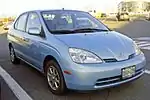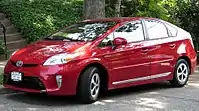Comparison of Toyota hybrids
By the end of 2006 there were about 15 hybrid vehicles from various car makers available in the U.S.[1] By May 2007 Toyota sold its first million hybrids and had sold a total of two million hybrids at the end of August 2009.[2]
Comparisons
Below is a comparison of the Toyota hybrid models.
| Features | Prius  |
Prius _liftback_(2012-06-24).jpg.webp) |
Prius  |
Prius _1.8_Hybrid_liftback_(2018-12-19)_01.jpg.webp) |
Camry _Ascent_Sport_Hybrid_sedan_(2018-08-13)_01.jpg.webp) |
Highlander  |
Highlander  |
|---|---|---|---|---|---|---|---|
| Release date | December 1997 (Japan) 2000 (worldwide) |
August 2003 | May 2009 (Japan) June 2009 (US) |
December 2015 | May 2006 | July 2005 | September 2007 |
| US model year | 2001–2003 | 2004–2009 | 2010–2015 | 2016– | 2007– | 2005–2007 | 2008– |
| Base price | US$19,995 | US$22,000 | US$22,000 | US$24,685 | US$26,480 | US$33,000 | US$34,700 |
| EPA-estimated city fuel economy | 42 mpg‑US (5.6 L/100 km; 50 mpg‑imp) | 48 mpg‑US (4.9 L/100 km; 58 mpg‑imp) | 51 mpg‑US (4.6 L/100 km; 61 mpg‑imp) | 54 mpg‑US (4.4 L/100 km; 65 mpg‑imp) | 33 mpg‑US (7.1 L/100 km; 40 mpg‑imp) | 28 mpg‑US (8.4 L/100 km; 34 mpg‑imp) (2WD) 27 mpg‑US (8.7 L/100 km; 32 mpg‑imp) (4WD-i) |
27 mpg‑US (8.7 L/100 km; 32 mpg‑imp) |
| EPA-estimated highway fuel economy | 41 mpg‑US (5.7 L/100 km; 49 mpg‑imp) | 45 mpg‑US (5.2 L/100 km; 54 mpg‑imp) | 48 mpg‑US (4.9 L/100 km; 58 mpg‑imp) | 50 mpg‑US (4.7 L/100 km; 60 mpg‑imp) | 34 mpg‑US (6.9 L/100 km; 41 mpg‑imp) | 25 mpg‑US (9.4 L/100 km; 30 mpg‑imp) (2WD) 25 mpg‑US (9.4 L/100 km; 30 mpg‑imp) (4WD-i) |
25 mpg‑US (9.4 L/100 km; 30 mpg‑imp) |
| EPA-estimated drivers fuel economy | 45 mpg‑US (5.2 L/100 km; 54 mpg‑imp) | 47.5 mpg‑US (4.95 L/100 km; 57.0 mpg‑imp) | 48.7 mpg‑US (4.83 L/100 km; 58.5 mpg‑imp) | 52 mpg‑US (4.5 L/100 km; 62 mpg‑imp) | 36.6 mpg‑US (6.43 L/100 km; 44.0 mpg‑imp) | 24.5 mpg‑US (9.6 L/100 km; 29.4 mpg‑imp) | |
| Engine | 1.5 L 1NZ-FXE I4 Atkinson cycle |
1.5 L 1NZ-FXE I4 Atkinson cycle |
1.8 L 2ZR-FXE I4 Atkinson cycle |
1.8 L 2ZR-FXE I4 Redesigned Atkinson cycle |
2.4 L 2AZ-FXE I4 Atkinson cycle |
3.3 L 3MZ-FE V6 | 3.3 L 3MZ-FE V6 |
| 0–60 mph (97 km/h) acceleration | 12.6 s | 10.8 s | 10.0 s | 9.6 s | 7.3 s (R&T, 5/06) | 6.6 s (Motor Trend) | n/a |
| Engine output | 70 hp (52 kW) / 82 lb·ft (110 Nm) | 76 hp (57 kW) / 85 lb·ft (115 Nm) | 98 hp (73 kW) / 105 lb·ft (142 Nm) | 95 hp (71 kW) / 105 lb·ft (142 Nm) | 147 hp (108 kW) / 138 lb·ft (187 Nm) | 156 kW (208 hp) | |
| Electric motor output | 44 hp (33 kW) / 259 lb·ft (350 Nm) | 68 hp (50 kW) / 295 lb·ft (400 Nm) | 80 hp (60 kW) / 153 lb·ft (207 Nm) | 71 hp (53 kW) / 120 lb·ft (163 Nm) | 45 hp (34 kW) | ||
| Net power | 60 kW (80 hp) | 80 kW (107 hp) | 110 kW (134 hp) | 90 kW (121 hp) | 140 kW (187 hp) | 201 kW (270 hp) | |
| Traction battery power | 33 kW (44 hp) | 21 kW (28 hp) | 27 kW (36 hp) | 53 kW (71 hp) | 30 kW (40 hp) | 45 kW (60 hp) | 45 kW (60 hp) |
| Requires premium fuel (91 octane (R+M)/2 ) | No | No | No | No | No | No (however, premium recommended) | No |
| EPA/CARB emission certification | Tier II Bin 3/AT-PZEV | Tier II Bin 3/SULEV | Tier II Bin 3/SULEV with AT-PZEV | Tier II Bin 3/AT-PZEV | Tier II Bin 3/AT-PZEV | Tier II Bin 3/SULEV | |
| Smog forming emissions compared to average new vehicle | 75% less | 80% less | 80% less | 80% less | 80% less | 80% less | 80% less |
| Maximum seating | 5 | 5 | 5 | 5 | 5 | 7 | 7 |
- Note: Miles per gallon estimates are those provided by the United States Environmental Protection Agency (EPA) and are the 2008 revision of the original numbers.
- Hybrid access to US HOV lanes varies by US state. Factors can include total/average miles per gallon rating from the EPA, type of technology used, and/or date of vehicle registration with the relevant state authorities. (Several states have begun restricting HOV lane access by hybrid and clean-fuel vehicles due to crowding.)
- Traction battery power is the amount of power available from the electric portion of the powertrain without the aid of the internal combustion engine (ICE). This is generally limited by the traction battery rather than the electric motor(s).
Notes
- Pernick, R. and Wilder, C. (2007). The Clean Tech Revolution, p. 4.
- "Toyota News Release: Worldwide Sales of TMC Hybrids Top 2 Million Units". 2009-09-04. Retrieved 2009-11-17.
References
- ^ "Camry Hybrid Reviews". JB car pages. Retrieved 2008-06-19.
- ^ "Highlander Hybrid Reviews". JB car pages. Retrieved 2008-06-19.
- ^ "Prius Specifications". Toyota.
- ^ "Camry Specifications". Toyota. Archived from the original on 2006-04-11. Retrieved 2006-04-11.
External links
- about.com hybrid comparison
- allabouthybridcars comparison
- Hybrid Synergy Drive movie from Toyota
- United States Environmental Protection Agency Fuel Economy Site
- 2016 Toyota Prius Specifications Revealed
- "Evaluation of the 2007 Toyota Camry Hybrid Synergy Drive system" from Oak Ridge National Laboratory has an extensive comparison between the 2004 Prius and 2007 Camry Hybrid systems
This article is issued from Wikipedia. The text is licensed under Creative Commons - Attribution - Sharealike. Additional terms may apply for the media files.